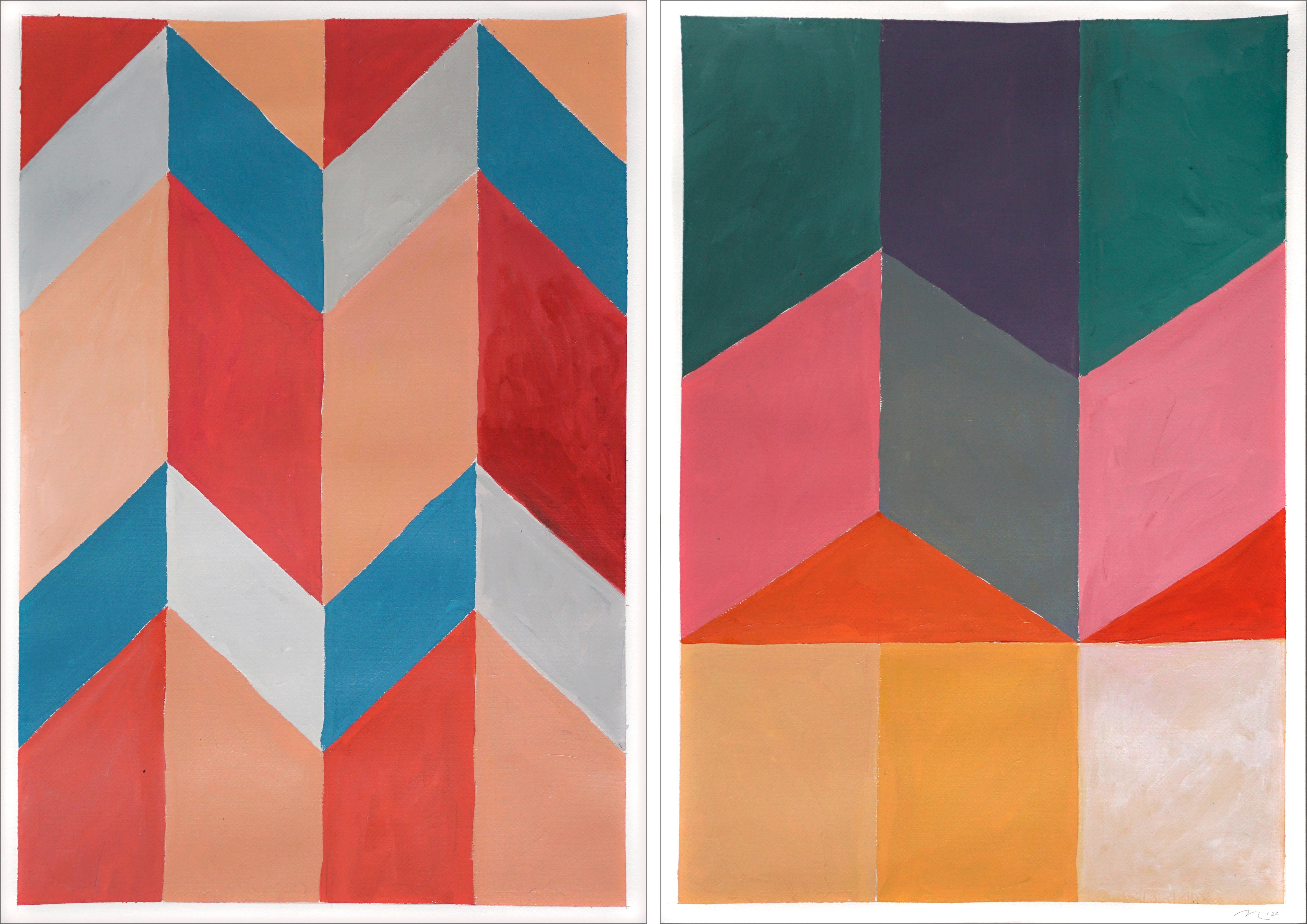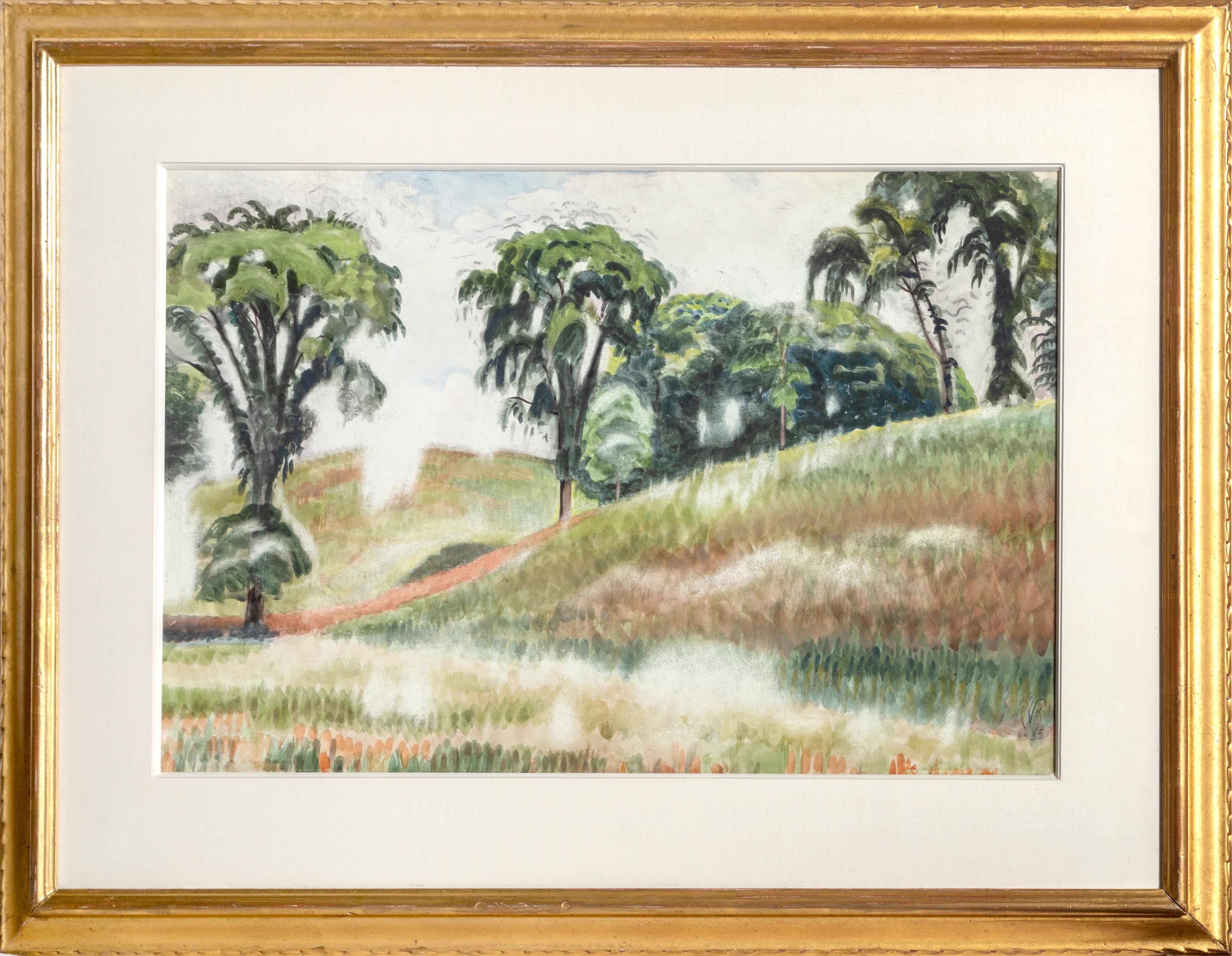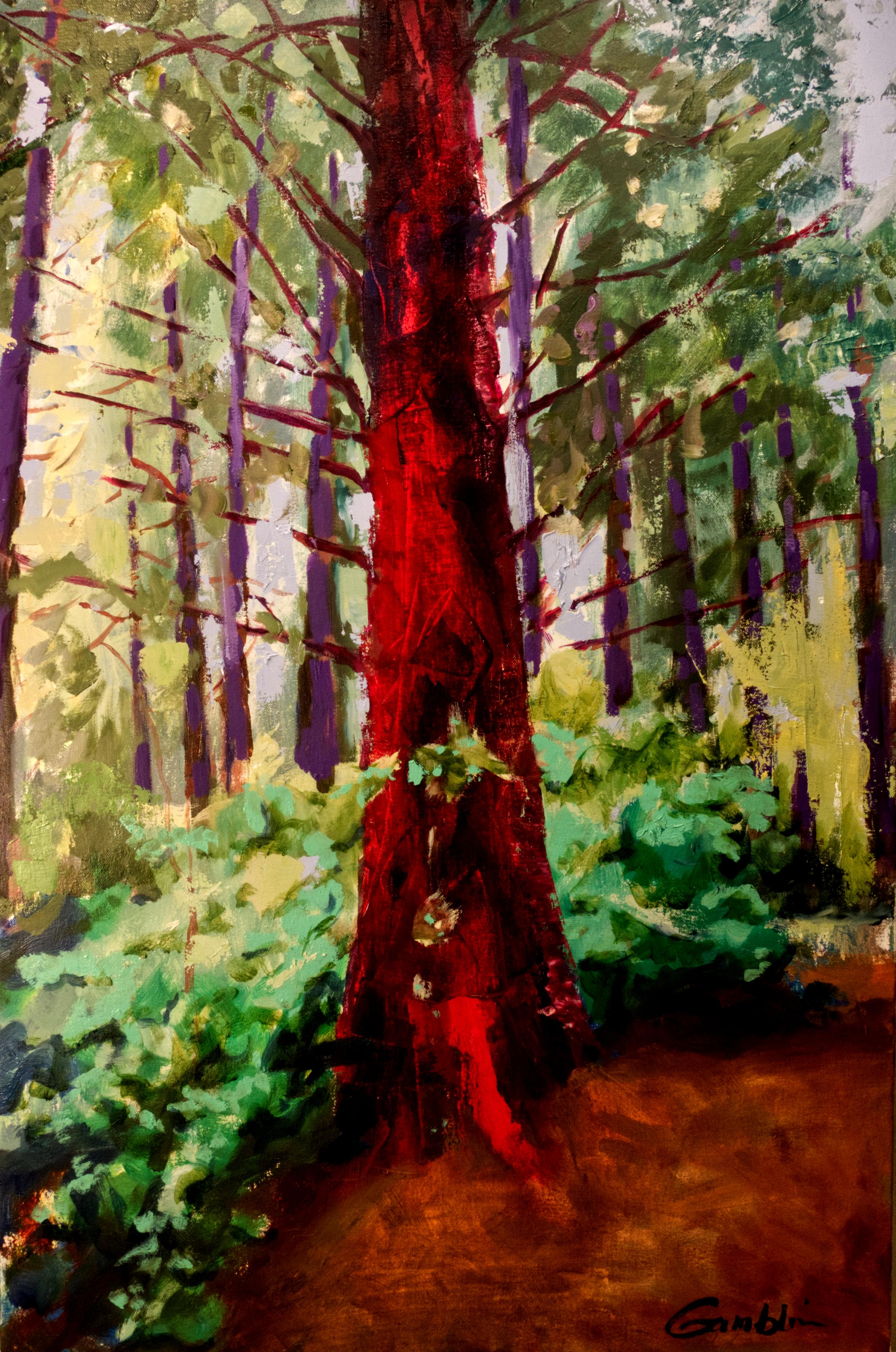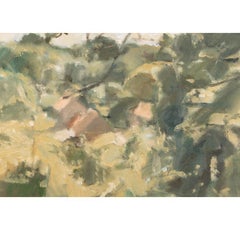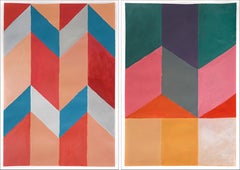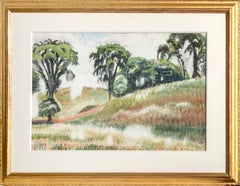Items Similar to Baiser de la fée (The Fairy's Kiss), Scene I, II, III (October) Painting, 1968
Want more images or videos?
Request additional images or videos from the seller
1 of 6
John HubbardBaiser de la fée (The Fairy's Kiss), Scene I, II, III (October) Painting, 19681968
1968
About the Item
Baiser de la fée (The Fairy's Kiss), Scene I, II, III (October) Painting by Hubbard 1931-2017, 1968
Additional information:
Medium: Oil on paper on board
44.5 x 78.5 cm
17 1/2 x 30 7/8 in
Signed, dated and titled
Provenance
Estate of the Artist
John Hubbard was an American-born abstract impressionist painter who worked in Britain.
Born in Connecticut on 26 February, Hubbard was the son of a lawyer. His family spent much of their time at their small farm in the countryside. Hubbard read English at Harvard University and, after graduating, completed three years of military service in Japan during the Korean War. On his return to the USA in 1956, Hubbard studied at the Art Students League of New York and with the hugely influential Abstract Expressionist painter Hans Hoffman. Other students of Hofmann include Lee Krasner, Helen Frankenthaler, Robert De Niro Sr., the designer Ray Eames and, briefly, Jackson Pollock. After finishing his education, Hubbard then moved to Rome, spending time travelling and painting throughout Italy and wider Europe. In 1961, Hubbard married and settled near Bridport in Dorset.
The artist had first visited England in 1958 and, like many others involved in the 'Ab-Ex' movement of New York, travelled to the popular artist’s colony of St Ives, where he met the painter Peter Lanyon. From this point on, Hubbard concentrated on a kind of landscape painting which goes beyond the depiction of appearance, alluding to natural forms and the rhythms of growing while recreating the experience of a particular place. In Dorset, the artist’s interests in East Asian painting and philosophy and early influences such as De Kooning, Rothko and Mark Tobey were applied to his contemplation of the natural world.
From 1963 to '65 Hubbard taught at Camberwell School of Art and worked as a designer and painter for various ballet companies. His designs included the costumes and décor for 'Le Baiser de la Fee' by the Dutch National Ballet in Amsterdam in 1968, the costumes and décor for 'Midsummer' by the Royal Ballet in London in 1983, and work for 'Sylvia' by the Royal Ballet in London in 1985. As a guest artist at the National Gallery of Malaysia in 1990, Hubbard also designed a series of batik hangings, still on display in Kuala Lumpur.
Hubbard enjoyed working in series, a method for further understanding natural changes, taking his inspiration from sites he visited in Greece, Morocco, and France. From his time growing up in rural America, Hubbard had long been passionate about gardening and the subject of the garden is a recurring theme in his work, including pieces inspired by Abbotsbury, Tresco, the Alhambra, and his own mature garden in Dorset. Making sketches and charcoal drawings en plein air, Hubbard would move into the studio to create his paintings with their extraordinary sense of drama and subtle use of light and colour.
From the 1960s onwards, Hubbard increasingly showed his paintings in exhibitions in Britain and abroad. This included solo shows at New Art Centre, London (1960-'61, '63, '65, '67, '69-'75), University of Leicester (1964), St Catherine's College, Oxford (1966), Aberdeen Art Gallery, Ikon Gallery Birmingham (both 1975), Newlyn Gallery (1978), Fischer Fine Art, London (1979 and '84). With a rising interest in his work, Hubbard was the subject of a film aired as part of the South Bank Show in 1981. In 1985, his success was rewarded with a solo exhibition at the Museum of Modern Art in Oxford and, the following year, a major retrospective at the Yale Center for British Art in New Haven, Connecticut.
In 1995, he was commissioned to create an installation for the entry hall to the headquarters of Smith & Nephew in London. In 1996 he was awarded the Jerwood Prize and was invited to create work to be included in 'Eight Variations on a Drawing by Rubens' at the Fitzwilliam Museum (1998). Other commissions include Dorchester Hospital (1990), Charleston Farmhouse, Sussex (1995), Rothschild Collection, Waddesdon Manor (2000), Said Business School, Oxford (2005), and Royal Parks, London (2008). In 1993, the artist was chosen as a Member of the Advisory Panel for Tate St. Ives. In 1997, he was chosen to curate Dorset County Museum's Elisabeth Frink exhibition.
Hubbard’s work is not representational, with water or sky suggested and alluded to, yet they are far from abstract. Specialising in "contained landscape and enclosed spaces" – quarries, caves, rocks, woodland – rather than grand sweeping views, he explored the atmosphere and the spirit of places such as the play of light through leaves or the textures of stone or foliage.
His work can be found in many public and private collections, including the Financial Times, Nuffield Foundation, Deutsche Bank, Yale Centre of British Art, Connecticut, National Gallery of Malaysia, Art Gallery of Ontario, Canada, National Gallery of Victoria, Melbourne, Philadelphia Museum of Fine Arts, Scottish National Gallery of Modern Art, Edinburgh, City Art Gallery, Bristol, New College, Oxford, Fitzwilliam Museum, Cambridge, Arts Council of Great Britain, V&A Museum, British Museum and Tate Gallery.
- Creator:John Hubbard (1931 - 2017, American)
- Creation Year:1968
- Dimensions:Height: 17.5 in (44.45 cm)Width: 30.88 in (78.44 cm)
- Medium:
- Period:
- Condition:
- Gallery Location:Kingsclere, GB
- Reference Number:1stDibs: LU2718214574552
About the Seller
No Reviews Yet
Vetted Seller
These experienced sellers undergo a comprehensive evaluation by our team of in-house experts.
1stDibs seller since 2024
24 sales on 1stDibs
Typical response time: 7 hours
- ShippingRetrieving quote...Ships From: Kingsclere, United Kingdom
- Return PolicyThis item cannot be returned.
Authenticity Guarantee
In the unlikely event there’s an issue with an item’s authenticity, contact us within 1 year for a full refund. DetailsMoney-Back Guarantee
If your item is not as described, is damaged in transit, or does not arrive, contact us within 7 days for a full refund. Details24-Hour Cancellation
You have a 24-hour grace period in which to reconsider your purchase, with no questions asked.Vetted Professional Sellers
Our world-class sellers must adhere to strict standards for service and quality, maintaining the integrity of our listings.Price-Match Guarantee
If you find that a seller listed the same item for a lower price elsewhere, we’ll match it.Trusted Global Delivery
Our best-in-class carrier network provides specialized shipping options worldwide, including custom delivery.More From This Seller
View AllStudy for Twin Arches, Gozo by Philip Jones, 1992 - Oil on Paper, Architectural
Located in Kingsclere, GB
Study for Twin Arches, Gozo, Oil on Paper Painting by Philip Jones 1933-2008, 1992
Additional information:
Medium: Oil on paper
35.6 x 41.9 cm
14 x 16 1/2 in
Signed, dated and title...
Category
20th Century Landscape Paintings
Materials
Paper, Oil
Dormers and Almshouse Welshpool, Oil on Paper Painting by Philip Jones, 2005
Located in Kingsclere, GB
Dormers and Almshouse Welshpool, Oil on Paper Painting by Philip Jones 1933-2008, 2005
Additional information:
Medium: Oil and pencil on paper
30.5 x 30.5 cm
12 1/8 x 12 1/8 in
Sign...
Category
20th Century Landscape Paintings
Materials
Paper
M. le Clerc's Farm (Rouen), Oil on Paper Painting by Dick Lee, 1988
By Dick Lee
Located in Kingsclere, GB
M. le Clerc's Farm (Rouen), Oil on Paper Painting by Dick Lee 1923-2001, 1988
Additional information:
Medium: Oil on paper
23.5 x 33.7 cm
9 1/4 x 13 1/4 in
Provenance
Acquired from...
Category
20th Century Landscape Paintings
Materials
Paper
Ionic at Welshpool, Oil on Paper Painting by Philip Jones, 2005
Located in Kingsclere, GB
Ionic at Welshpool, Oil on Paper Painting by Philip Jones 1933-2008, 2005
Additional information:
Medium: Oil and pencil on paper
30.5 x 30.5 cm
12 1/8 x 12 1/8 in
Signed, titled an...
Category
21st Century and Contemporary Landscape Paintings
Materials
Paper
Water Movements, Oil on Paper Painting by John Hubbard, 1968
By John Hubbard
Located in Kingsclere, GB
Water Movements, Oil on Paper Painting by John Hubbard 1931-2017, 1968
Additional information:
Medium: Oil on paper
57 x 69 cm
22 1/2 x 27 1/8 in
signed and dated 'XI-68'
Writing o...
Category
20th Century Landscape Paintings
Materials
Paper
Buildings and Lamp, Oil on Board Painting by John Christopherson, 1977
Located in Kingsclere, GB
Buildings and Lamp, Oil on Board Painting by John Christopherson, 1977
Additional information:
Medium: Oil on board
35 x 44 cm
13 3/4 x 17 3/8 in
Signed with initials; signed again and inscribed verso; further inscribed on an Artist's label attached verso
John Christopherson was a painter of small dreamlike townscapes and abstract paintings that combine an almost naïve intensity with great sophistication.
Born in Blackheath, London in 1921, Christopherson began his working life at Shell-Mex House in 1938, the period when Jack Beddington, the manager of the publicity department was pioneering the use of modern art in advertising. After a wartime illness, Christopherson worked at County Hall in London, choosing for his office wall a print of Paul Nash's Wood on the Downs and Nash's primeval landscapes and magical moons were later to have a lasting influence on Christopherson's own paintings.
In 1950, while working as a civil servant at the Geological Museum in South Kensington, he became interested in the French Art Brut movement and corresponded with Jean Dubuffet, who offered encouragement when Christopherson himself began to paint.
John Christopherson felt that his life in art did not really begin until 1950, when he met Jacob Epstein and started to visit West End galleries - he said that it was a revelation that 'such a magical world co-existed on the same level and at the same time as the boring, prosaic one of rationing, coupons and the civil service', and he determined to enter it. He said that his annus mirabilis was 1951, the year of the Festival of Britain. This was the time when his tastes and interests were moulded and when he found his vocation. In 1959, he resigned from his appointment in the civil service at the Geological Museum and became a full-time painter.
From boyhood he was fascinated by the idea of antiquity. He was always interested in ancient stones, pavements, mosaics, archaeological sites, walls and buildings which had gradually changed and been eroded by time. Walls with faded posters and graffiti particularly attracted him - he treasured and identified himself with what he described as the 'forlorn poetry of the unregarded'.
Christopherson's pictures linger in the memory. His image world is a distillation of cultural debris sifted with poetic intensity. His pictures are a microcosm of his tastes and obsessions. Each small painting is haunted by a sense of déjà vu, the ordinary becomes extraordinary. The subtle depths of layers of glazes are incised with the mysterious markings of a private language. Terence Mullaly once described how his works 'convey the impression of a world frozen in a dream'. George Melly...
Category
20th Century Landscape Paintings
Materials
Board, Oil
You May Also Like
Sandy Tones Inverted Dunes, Fractal Geometric Diptych, Green Bauhaus Patterns
By Natalia Roman
Located in Barcelona, ES
These series of paintings by Natalia Roman gather their inspiration from geometric, minimalist shapes and paintings from the beginning of Modernism, with a special emphasis on Art De...
Category
2010s Analytic Cubist Abstract Paintings
Materials
Acrylic, Paper
Lisa Palombo, "Secretariat Tremendous Machine" Blue Horse Race Painting
Located in Saratoga Springs, NY
This bold and colorful equine impressionist painting, "Secretariat Tremendous Machine" by artist Lisa Palombo is a 24x18 acrylic painting on canvas. Depic...
Category
2010s Impressionist Animal Paintings
Materials
Archival Paper, Acrylic
Scene on Windspear Road, Watercolor by Charles Burchfield 1935
By Charles E. Burchfield
Located in Long Island City, NY
A watercolor painting by Charles Burchfield from 1935. An impressionist landscape of green foliage and a grassy hill in soft earth tones. Signed and dated in the lower right, beautif...
Category
1930s Impressionist Landscape Paintings
Materials
Watercolor, Paper
Fishing Camp on the Labrador Coast
By William Bradford
Located in New York, NY
In 1852, twenty-nine year old William Bradford was a failing shopkeeper in Fairhaven, Massachusetts. With a wife and child at home, Bradford, by his own admission, “spent too much time in painting to succeed” in business. Rescued from insolvency by his well-to-do in-laws, this is not the beginning of a narrative that generally leads to a happy ending. Not so with Bradford, who ultimately found international fame and fortune as a painter of arctic seascapes and dramatic marine paintings.
William Bradford, the artist, was a lineal descendant of the 17th-century Separatist leader William Bradford, a founder of the Plymouth Plantation, signer of the Mayflower Compact and Governor of the Plymouth Colony. Our Bradford born to a New Bedford ship outfitter in Fairhaven, Massachusetts By the nineteenth century, this line of Bradfords were Quakers, living on the tract purchased nearly two centuries earlier by their pilgrim ancestor. Fairhaven, across the mouth of the Acushnet River from the whaling center of New Bedford was described by a New York journalist in 1857 as “the Brooklyn of New Bedford” (Home Journal, January 3, 1857). Young Bradford displayed an early predilection for the arts, but his Quaker parents were disinclined to support this particular pursuit. After working in his father’s business and then for a dry goods merchant in New Bedford, by 1849 Bradford had set up in New Bedford as a “merchant tailor” offering outfits for “those going to California,” “seamen’s clothing,” custom-tailored “piece goods...
Category
19th Century American Realist Landscape Paintings
Materials
Canvas, Paper, Oil
Sitka 15
Located in Burlingame, CA
Robert Gamblin’s intent as an artist is to reach for transcendence through his color-centric oil paintings that capture the majesty of light as it graces the Earth. In this series, o...
Category
21st Century and Contemporary American Realist Landscape Paintings
Materials
Paper, Oil
Sitka 14
Located in Burlingame, CA
Robert Gamblin’s intent as an artist is to reach for transcendence through his color-centric oil paintings that capture the majesty of light as it graces the Earth. In this series, o...
Category
21st Century and Contemporary American Realist Landscape Paintings
Materials
Paper, Oil
Recently Viewed
View AllMore Ways To Browse
Financial Paper
John Smith Vintage
Japanese World War Ii
Vintage Ballet Costume
17 Century Dutch Frame
Royal Garden Design Drawing
Royal Korean Art
Kiss Play
Studio 1 Amsterdam
World War 2 Sketches
2008 Eames
Eames La
Vintage Alhambra
Moroccan Costume
Tobey Mark
Melbourne Smith
Eames Panel
Framed Cambridge And Oxford Paintings
